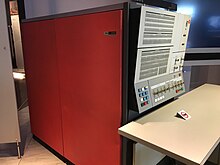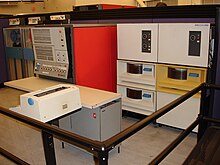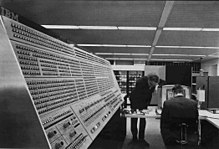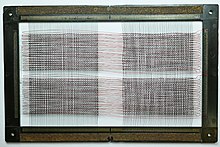
A | B | C | D | E | F | G | H | CH | I | J | K | L | M | N | O | P | Q | R | S | T | U | V | W | X | Y | Z | 0 | 1 | 2 | 3 | 4 | 5 | 6 | 7 | 8 | 9
 | |
 IBM System/360 Model 30 central processor unit (CPU) | |
| Also known as | S/360 |
|---|---|
| Developer | IBM |
| Manufacturer | IBM |
| Product family | See table of models |
| Type | Mainframe computer |
| Release date | April 7, 1964 |
| Discontinued | 1978 |
| Media | |
| Operating system | |
| Memory | 8 KB – 9 MB (core memory) |
| Predecessor | 700/7000 series |
| Successor | System/370 |
| Related | System/360 architecture |
| History of IBM mainframes, 1952–present |
|---|
| Market name |
| Architecture |
The IBM System/360 (S/360) is a family of mainframe computer systems that was announced by IBM on April 7, 1964, and delivered between 1965 and 1978.[1] It was the first family of computers designed to cover both commercial and scientific applications and a complete range of applications from small to large. The design distinguished between architecture and implementation, allowing IBM to release a suite of compatible designs at different prices. All but the only partially compatible Model 44 and the most expensive systems use microcode to implement the instruction set, featuring 8-bit byte addressing and fixed point binary, fixed point decimal and hexadecimal floating-point calculations.
The System/360 family introduced IBM's Solid Logic Technology (SLT), which packed more transistors onto a circuit card, allowing more powerful but smaller computers.[2]
The slowest System/360 model announced in 1964, the Model 30, could perform up to 34,500 instructions per second, with memory from 8 to 64 KB.[3] High-performance models came later. The 1967 IBM System/360 Model 91 could execute up to 16.6 million instructions per second.[4] The larger 360 models could have up to 8 MB of main memory,[5] though that much memory was unusual; a large installation might have as little as 256 KB of main storage, but 512 KB, 768 KB or 1024 KB was more common. Up to 8 megabytes of slower (8 microsecond) Large Capacity Storage (LCS) was also available for some models.
The IBM 360 was extremely successful, allowing customers to purchase a smaller system knowing they could expand it, if their needs grew, without reprogramming application software or replacing peripheral devices. It influenced computer design for years to come; many consider it one of history's most successful computers.
System/360's chief architect was Gene Amdahl, and the project was managed by Fred Brooks, responsible to Chairman Thomas J. Watson Jr.[5] The commercial release was piloted by another of Watson's lieutenants, John R. Opel, who managed the launch of IBM’s System 360 mainframe family in 1964.[6]
Application-level compatibility (with some restrictions) for System/360 software is maintained to the present day with the System z mainframe servers.
System/360 history




Charting a new course
By the early 1960s, IBM was struggling with the load of supporting and upgrading five separate lines of computers. These were aimed at different market segments and were entirely different from each other. A customer who purchased a machine to handle accounting, such as the IBM 1401, that was now looking for a machine for engineering calculations, such as the IBM 7040, had no reason to select IBM - the 7040 was incompatible with the 1401 and they might as well have been from different companies. Customers were frustrated that major investments, often entirely new machines and programs, were required when seemingly small performance improvements were needed.[7]
In 1961, IBM assembled a task force to chart their developments for the 1960s, known as SPREAD, for Systems Programming, Research, Engineering and Development. In meetings at the New Englander Motor Hotel in Greenwich, Connecticut, SPREAD developed a new concept for the next generation of IBM machines. At the time, new technologies were coming into the market including the introduction of replacement of individual transistors with small-scale integrated circuits and the move to an 8-bit byte from the former 6-bit oriented words. These were going to lead to a new generation of machines, today known as the third generation, from all of the existing vendors.[7]
Where SPREAD differed significantly from previous concepts was what features would be supported. Instead of machines aimed at different market niches, the new concept was effectively the union of all of these designs. A single instruction set architecture (ISA) included instructions for binary, floating point, and decimal arithmetic, string processing, conversion between character sets (a major issue before the widespread use of ASCII) and extensive support for file handling, among many other features.[7]
This would mean IBM would be introducing yet another line of machines, once again incompatible with their earlier machines. But the new systems would be able to run all of the programs that formerly required different machines. A concern was that there was a risk that their customers, facing the purchase of yet another new and incompatible platform, would simply choose some other vendor. Yet the concept steadily gained support, and six months after being formed, the company decided to implement the SPREAD concept.[7]
A new team was organized under the direction of Bob Evans, who personally persuaded CEO Thomas J. Watson Jr. to develop the new system. Gene Amdahl was the chief architect of the computers themselves, while Fred Brooks was the project lead for the software and Erich Bloch led the development of IBM's hybrid integrated circuit designs, Solid Logic Technology.[8]
A family of computers
Producing a single machine with support for all of these features would border on impossible. Instead, the SPREAD concept was based on the separation of the defined feature set from its internal operation, with a family of machines with different performance and different internal designs. Specifically, depending on the machine, some instructions might not be directly supported in hardware, and would instead be completed using small programs, in an internal machine-specific code, stored in read only memory, or what today is known as microcode.[9]
So a model intended for use with accounting might choose to implement the decimal math directly in hardware, and leave the floating point instructions to be handled by the subprograms. This would make floating point on such a system run (much) more slowly, but, critically, it would run. Likewise, a company purchasing a system for engineering support would choose a model with floating point hardware, and might use it from time to time to run their payroll. Using previous designs, the system that performed floating point would generally not have any support for decimal math all, and would require the customer to write such a package or buy another machine.
This meant that a single lineup could have machines tailored to match the price and performance niches that formerly demanded entirely separate computer systems. This flexibility greatly lowered barriers to entry. With most other vendors customers had to choose between machines they might outgrow or machines that were potentially too powerful and thus too costly. In practice, this meant that many companies simply did not buy computers. Now, a customer could purchase a machine that solved a particular requirement, knowing they could change the models as their needs changed, without losing support for the programs they were already running.[7]
For instance, in the case of a firm that purchased an accounting system and was now looking to expand their computer support into engineering, this meant they could develop and test their engineering program on the machine they already used. If they ever needed more performance, they could purchase a machine with floating point hardware, knowing that nothing else would change, it would simply get faster. Even the same peripherals could be used, allowing, for instance, data from the engineering system to be written to tape and then printed using a high-speed line printer already connected to their accounting system. Or they might replace the accounting system outright with a system with the performance to run both tasks.[7]
The idea that a single design could address all the myriad ways that the machines could be used gave rise to the name, "360" is a reference to 360 degrees in a circle, and circles of machines and components featured prominently in IBM's advertizing.[7]
Models
IBM initially announced a series of six computers and forty common peripherals. IBM eventually delivered fourteen models, including rare one-off models for NASA. The least expensive model was the Model 20 with as little as 4096 bytes of core memory, eight 16-bit registers instead of the sixteen 32-bit registers of other System/360 models, and an instruction set that was a subset of that used by the rest of the range.
The initial announcement in 1964 included Models 30, 40, 50, 60, 62, and 70. The first three were low- to middle-range systems aimed at the IBM 1400 series market. All three first shipped in mid-1965. The last three, intended to replace the 7000 series machines, never shipped and were replaced with the 65 and 75, which were first delivered in November 1965, and January 1966, respectively.
Later additions to the low-end included models 20 (1966, mentioned above), 22 (1971), and 25 (1968). The Model 20 had several sub-models; sub-model 5 was at the higher end of the model. The Model 22 was a recycled Model 30 with minor limitations: a smaller maximum memory configuration, and slower I/O channels, which limited it to slower and lower-capacity disk and tape devices than on the 30.
The Model 44 (1966) was a specialized model, designed for scientific computing and for real-time computing and process control, featuring some additional instructions, and with all storage-to-storage instructions and five other complex instructions eliminated.


A succession of high-end machines included the Model 67 (1966, mentioned below, briefly anticipated as the 64 and 66[10]), 85 (1969), 91 (1967, anticipated as the 92), 95 (1968), and 195 (1971). The 85 design was intermediate between the System/360 line and the follow-on System/370 and was the basis for the 370/165. There was a System/370 version of the 195, but it did not include Dynamic Address Translation.
The implementations differed substantially, using different native data path widths, presence or absence of microcode, yet were extremely compatible. Except where specifically documented, the models were architecturally compatible. The 91, for example, was designed for scientific computing and provided out-of-order instruction execution (and could yield "imprecise interrupts" if a program trap occurred while several instructions were being read), but lacked the decimal instruction set used in commercial applications. New features could be added without violating architectural definitions: the 65 had a dual-processor version (M65MP) with extensions for inter-CPU signalling; the 85 introduced cache memory. Models 44, 75, 91, 95, and 195 were implemented with hardwired logic, rather than microcoded as all other models.
The Model 67, announced in August 1965, was the first production IBM system to offer dynamic address translation (virtual memory) hardware to support time-sharing. "DAT" is now more commonly referred to as an MMU. An experimental one-off unit was built based on a model 40. Before the 67, IBM had announced models 64 and 66, DAT versions of the 60 and 62, but they were almost immediately replaced with the 67 at the same time that the 60 and 62 were replaced with the 65. DAT hardware would reappear in the S/370 series in 1972, though it was initially absent from the series. Like its close relative, the 65, the 67 also offered dual CPUs.
IBM stopped marketing all System/360 models by the end of 1977.[11]
Backward compatibility
IBM's existing customers had a large investment in software that ran on second-generation machines. Several System/360 models had the option of emulating the customer's existing computer using special hardware[12] and microcode, and an emulation program that enabled existing programs to run on the new machine.
| System/360 model | Emulated systems | |||||
|---|---|---|---|---|---|---|
| 1401 | 1440, 1460 | 1410, 7010 | 7070, 7072, 7074 | 7080 | 709, 7090, 7094, 7094 II, 7040, 7044 | |
| Model 20 | Yes | |||||
| Model 30 | Yes | Yes | ||||
| Model 40 | Yes | Yes | Yes | |||
| Model 50 | Yes | Yes | Yes | Yes | ||
| Model 65 | Yes | Yes | Yes | |||
| Model 85 | Under OS control | |||||
Customers initially had to halt the computer and load the emulation program.[13] IBM later added features and modified emulator programs to allow emulation of the 1401, 1440, 1460, 1410 and 7010 under the control of an operating system. The Model 85 and later System/370 maintained the precedent, retaining emulation options and allowing emulators to run under OS control alongside native programs.[14][15]
Successors and variants
System/360 (excepting the Models 20, 44[NB 1] and 67[NB 2]) was replaced with the compatible System/370 range in 1970 and Model 20 users were targeted to move to the IBM System/3. (The idea of a major breakthrough with FS technology was dropped in the mid-1970s for cost-effectiveness and continuity reasons.) Later compatible IBM systems include the 4300 family, the 308x family, the 3090, the ES/9000 and 9672 families (System/390 family), and the IBM Z series.
Computers that were mostly identical or compatible in terms of the machine code or architecture of the System/360 included Amdahl's 470 family (and its successors), Hitachi mainframes, the UNIVAC 9000 series,[16] Fujitsu as the Facom, the RCA Spectra 70 series,[NB 3] and the English Electric System 4.[NB 4] The System 4 machines were built under license to RCA. RCA sold the Spectra series to what was then UNIVAC, where they became the UNIVAC Series 70. UNIVAC also developed the UNIVAC Series 90 as successors to the 9000 series and Series 70.[16] The Soviet Union produced a System/360 clone named the ES EVM.[17]
The IBM 5100 portable computer, introduced in 1975, offered an option to execute the System/360's APL.SV programming language through a hardware emulator. IBM used this approach to avoid the costs and delay of creating a 5100-specific version of APL.
Special radiation-hardened and otherwise somewhat modified System/360s, in the form of the System/4 Pi avionics computer, are used in several fighter and bomber jet aircraft. In the complete 32-bit AP-101 version, 4 Pi machines were used as the replicated computing nodes of the fault-tolerant Space Shuttle computer system (in five nodes). The U.S. Federal Aviation Administration operated the IBM 9020, a special cluster of modified System/360s for air traffic control, from 1970 until the 1990s. (Some 9020 software is apparently still used via emulation on newer hardware.[citation needed])
Table of System/360 models
| Model | Announced[18] | Shipped[18] | Scientific performance (kIPS)[NB 5] |
Commercial performance (kIPS)[NB 6] |
CPU Bandwidth (MB/sec)[19] |
Memory bandwidth (MB/sec)[19] |
Memory size (in (binary) KB) |
Weight (lbs) |
Notes |
|---|---|---|---|---|---|---|---|---|---|
| 30 | Apr 1964 | Jun 1965 | 10.2 | 29 | 1.3 | 0.7 | 8–64[20] | 1,700 lb (771 kg)[21]: 2030.1 | |
| 40 | Apr 1964 | Apr 1965 | 40 | 75 | 3.2 | 0.8 | 16–256[22] | 1,700–2,310 lb (771–1,048 kg) depends on memory[21]: 2040.1 |
|
| 50 | Apr 1964 | Aug 1965 | 133 | 169 | 8.0 | 2.0 | 64–512[23] | 4,700–7,135 lb (2,132–3,236 kg) depends on memory[21]: 2050.2, 2050.4 |
Supported IBM 2361 Large Capacity Storage (LCS). |
| 60 and 62 | Apr 1964 | never | Replaced by Model 65 | ||||||
| 70 | Apr 1964 | never | Replaced by Model 75 | ||||||
| 90 | Apr 1964 | never | Replaced by Model 92 | ||||||
| 92 | Aug 1964 | never | Redesignated as IBM System/360 Model 91[18] | ||||||
| 20 | Nov 1964 | Mar 1966 | 2.0 | 2.6 | 4–32[24] | 1,200–1,400 lb (544–635 kg)[25] | 16-bit, low end, limited partially incompatible instruction set | ||
| 91 | Jan 1966[18]: p.394 | Oct 1967 | 1,900 | 1,800 | 133 | 164 | 1,024–4,096[26] | Available on special bid beginning Nov 1964[18]: 388 | |
| 64 and 66 | Apr 1965 | never | Replaced by Model 67 | ||||||
| 65 | Apr 1965 | Nov 1965 | 563 | 567 | 40 | 21 | 128–1,024[27] | 4,290–8,830 lb (1,946–4,005 kg) depends on memory and number of processors[21]: 2065.2, 2065.4, 2065.6, 2065.8, 2065.10 |
Supported LCS |
| 75 | Apr 1965 | Jan 1966 | 940 | 670 | 41 | 43 | 256–1,024[28] | 5,125–5,325 lb (2,325–2,415 kg) depends on memory[21]: 2075.2, 2075.4 |
Supported LCS |
| 67 | Aug 1965 | May 1966 | 40 | 21 | 512–2,048[29] | 3,674 lb (1,666 kg) – Processor only[21]: 2067.6 | Dynamic address translation for time sharing | ||
| 44 | Aug 1965 | Sep 1966 | 118 | 185 | 16 | 4.0 | 32–256[30] | 2,900–4,200 lb (1,315–1,905 kg) depends on memory[21]: 2044.2 |
Specialized for scientific computing |
| 95 | special order | Feb 1968 | 3,800 est. | 3,600 est. | 133 | 711 | 5,220[31] | Performance estimated as 2× Model 91[18]: p.394 | |
| 25 | Jan 1968 | Oct 1968 | 9.7 | 25 | 1.1 | 2.2 | 16–48[32] | 2,050 lb (930 kg)[21]: 2025.2 | |
| 85 | Jan 1968 | Dec 1969 | 3,245 | 3,418 | 100 | 67 | 512–4,096[33] | 14,428 lb (6,544 kg) - Processor only[21]: 2085.2 | 16–32 KB cache memory, extended-precision floating point. |
| 195 | Aug 1969 | Mar 1971 | 10,000 est. | 10,000 est. | 148 | 169 | 1,024–4,096[34] | 13,450–28,350 lb (6,101–12,859 kg) depends on memory[21]: 3195.2, 3195.4 |
32 KB IC cache memory. Performance estimated as 3× Model 85.[18]: p.422 |
| 22 | Zdroj:https://en.wikipedia.org?pojem=System/360
